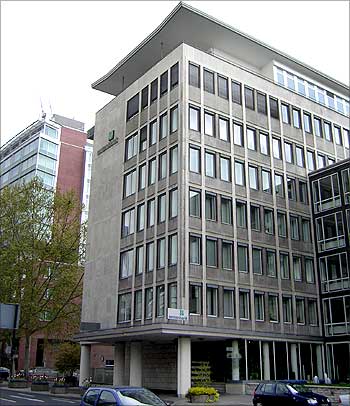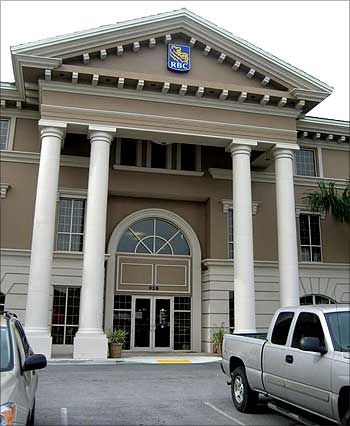 | « Back to article | Print this article |
World's 10 safest banks
Here's something to chew on: In a list of the world's 50 safest banks, there is not a single Indian bank -- despite the fact that Indian banking system was termed one of the most robust because it was not affected by the financial crises that hit banks across the globe.
Be that as it may, bank stability seems to high on corporate and investor agenda now. And it is against this backdrop that the Global Finance magazine has published its 18th annual list of the world's safest banks.
The dust seems to be settling now after two eventful years that witnessed many financial giants drop out of the top-50 safest banks list. Those banks that showed their grit amid an apparently insurmountable financial crisis topped the chart in this year's ranking.
At the same time, the big name banks that lost their safest bank ranking during the credit crunch are still absent from the list as they struggle to rebuild their credibility.
How the selection was made
The 'World's 50 Safest Banks 2009' were selected through a comparison of the long-term credit ratings and total assets of the 500 largest banks around the world. Ratings from Moody's, Standard & Poor's and Fitch were used.
Global Finance has published its 'World's Safest Banks' listing for 18 years and this ranking has become a recognised and trusted standard of creditworthiness for the entire financial world. Here's the list of the world's safest banks with an overview of the top 10. Read on. . .
World's 10 safest banks
1. KfW (Germany)
Founded in 1948, KfW is a German government-owned development bank based in Frankfurt. The bank was formed after World War II as part of the Marshall Plan.
Earlier, it went under the name: Kreditanstalt fur Wiederaufbau, or Reconstruction Credit Institute.
The bank's revenue stood at Euro70.6 billion in 2008. Number of its employees stood at 4,228 in the same year.
Recently, KfW tied up with the Industrial Development Bank of India to help Indian companies identify projects, fund them and help earn carbon credits.
World's 10 safest banks
2. Caisse des Depots et Consignations (France)
Created in 1816, Caisse des Depots et Consignations is a French financial organisation under the control of the Frnech Parliament.
The Caisse des Depots consists of the public institution Caisse des Depots and its subsidiaries. Its subsidiaries are involved in the competitive area.
It operates throughout France and in over 80 countries.
World's 10 safest banks
3. Bank Nederlands Gemeenten (Netherlands)
The Bank Nederlandse Gemeenten is a Dutch bank which was founded in 1914 in The Hague. It specialises in providing financing for (semi-)publicly owned organisations.
Ranked by assets alone, it is ranked as the 4th bank in the Netherlands. The company is owned for 50 per cent by the Dutch state, while the remainder is owned by the municipalities and provinces.
In the first half of 2009, the net profit of Bank Dutch Municipalities stood at Euro 114 million compared to Euro 73 million in 2008.
World's 10 safest banks
4. Landwirtschaftliche Rentenbank (Germany)
Rentenbank, based in Frankfurt am Main, is Germany's development agency for agri business. Rentenbank provides refinancing to banks within the European Union involved in financing agriculture, related sectors thereof and rural areas.
Rentenbank's roots go back to the days of the Deutsche Rentenbank, founded in 1923 to combat the hyperinflation problems of the times. In 1925, it became Deutsche Rentenbank-Kreditanstalt (RKA) and the central refinancing institution for the agricultural sector.
The bank's total assets in 2008 decreased slightly to Euro 87.9 billion while its total capital stood at Euro 3047.2 million.
World's 10 safest banks
5. Zuercher Kantonalbank (Switzerland)
On February 15 1870, the Zurich Cantonal Bank opened its first switch. Mortgages and other capital needs for workers, artisans and clerks, for agricultural and industrial enterprises and for small and medium industrial enterprises have been largely neglected by the former private banks.
Towards the end of the 19th and at the beginning of last century, the Zurich economy experienced a remarkable boom. The result was an increased demand for housing and rising rents. As a result, the bank saw substantial growth.
In 2008, the bank's total assets stood at 113 billion francs and its net income at 503 million francs.
World's 10 safest banks
6. Rabobank Group (Netherlands)
Rabobank Group is an international financial services provider operating on the basis of cooperative principles.
It offers retail banking, wholesale banking, asset management, leasing and real estate services. The bank focuses on all-finance services in the Netherlands and on food & agri internationally.
Rabobank Group comprises 152 independent local Rabobanks plus Rabobank Nederland, their central organisation, and a number of subsidiaries.
Rabobank's roots lie in agriculture. In 1898 two separate cooperative banks -- the Cooperatieve Centrale Raiffeisen-Bank in Utrecht and the Cooperatieve Centrale Boerenleenbank in Eindhoven -- were founded by enterprising rural folk, who, with little access to the capital market, decided to help one another.
The two banks served their rural communities independently for three-quarters of a century, both successfully practicing cooperative banking principles.
Therefore, their 1972 merger was a logical partnership.
In the first half of 2009, the bank's net profit stood at Euro 1.3 billion.
World's 10 safest banks
7. Landeskreditbank Baden-Wuerttemberg-Foerderbank (Germany)
It is a former public-law institution, which is wholly owned by the state of Baden-Wuerttemberg. The bank is headquarterd in Karlsruhe, and a branch office is located in Stuttgart.
The bank was founded in 1922 by Eugen Bolz, interior and finance minister, Wuerttemberg. The bank started its work in 1924 to counter the housing shortage especially after the World War I.
World's 10 safest banks
8. NRW Bank (Germany)
This is development bank for North Rhine-Westphalia.
North Rhine-Westphalia is Germany's largest province and is among the 15 largest economies in the world.
The bank's net income in 2008 stood at Euro 32.4 million whereas its net interest income stood at Euro 509.1 million.
World's 10 safest banks
9. BNP Paribas (France)
BNP Paribasis a major European bank. It was created on May 23, 2000 through the merger of Banque Nationale de Paris and Paribas. As on January 31 2008, the bank's assets stood at $1,899.186 billion.
It's history can be traced back to 1869, when a group of bankers and investors, including Adrien Delahante, Edmond Joubert and Henri Cernuschi, founded the Banque de Paris.
The bank employs 162,700 people and operates in 87 countries. The bank is active in the finance, investment and asset management markets.
World's 10 safest banks
10. Royal Bank of Canada (Canada)
The Royal Bank of Canada is the largest financial institution in Canada, measured by deposits, revenues, and market capitalisation.
The company's primary corporate offices are located in Toronto, Ontario, while it is officially headquartered in Montreal, Quebec. The bank was founded in 1864 in Halifax, Nova Scotia.
The bank serves 17 million clients and has 80,000 employees worldwide.
In Canada, the bank is branded as RBC Royal Bank in English and RBC Banque Royale in French
The bank's revenue stood at $25.34 Billion CAD in 2008 and net income at $4.64 billion CAD.
World's 10 safest banks
The other 40 banks that made it to the 50 safest banks' list are:
11. National Australia Bank (Australia);
12. Commonwealth Bank of Australia (Australia);
13. Banco Santander (Spain);
14. Toronto-Dominion Bank (Canada);
15. Australia & New Zealand Banking Group (Australia);
16. Westpac Banking Corporation (Australia);
17. ASB Bank Limited (New Zealand);
18. HSBC Holdings plc (United Kingdom);
19. Credit Agricole S.A. (France);
20. Banco Bilbao Vizcaya Argentaria (Spain);
21. Nordea Bank AB (publ) (Sweden);
22. Scotiabank (Canada);
23. Svenska Handelsbanken (Sweden);
24. DBS Bank (Singapore);
25. Banco Espanol de Credito S.A. (Spain);
26. Caisse centrale Desjardins (Canada);
27. Pohjola Bank (Finland);
28. Deutsche Bank AG (Germany);
29. Intesa Sanpaolo (Italy);
30. Caja de Ahorros y Pensiones de Barcelona (Spain);
31. Bank of Montreal (Canada);
32. The Bank of New York Mellon Corporation (United States);
33. DnB NOR Bank (Norway);
34. Caixa Geral de Depositos (Portugal);
35. United Overseas Bank (Singapore);
36. Oversea-Chinese Banking Corp. (Singapore);
37. CIBC (Canada);
38. National Bank Of Kuwait (Kuwait);
39. J.P. Morgan Chase & Co.(United States);
40. UBS AG (Switzerland);
41. Societe Generale (France);
42. Wells Fargo & Co. (United States);
43. Credit Suisse Group (Switzerland);
44. Banque Federative du Credit Mutuel (France);
45. Credit Industriel et Commercial (France);
46. Nationwide Building Society (United Kingdom);
47. US Bancorp (United States);
48. Shizuoka Bank (Japan);
49. Northern Trust Corporation (United States);
50. National Bank of Abu Dhabi (United Arab Emirates)











